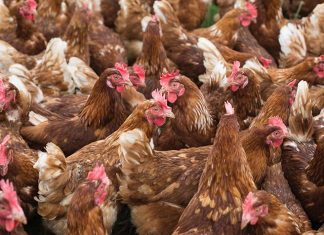
Between 1996 and 2016, global egg production increased from 45.1 mill. t to 73.9 mill. t or by 64.0%. Asian countries contributed 19.6 mill. t or 68.1% to the global growth. In the same time period, the global laying hen inventory grew from 3.8 billion hens to 6.1 billion hens. Asian countries shared 1.6 billion hens or 68.4% in the global increase. When looking at these dynamics in more detail, one can easily see that three countries played a decisive role in Asia’s dominance in the global egg industry: China, India and Japan. In 2016, they contributed 45.5% to the global egg production volume and 74.7% to egg production in Asia. In a series of four papers, an overview will be given on the dynamics of the egg industry in Asia and in the three leading countries: China, India and Japan.
The extraordinary role of this continent in global egg production
In 2016, Asia shared 59.4% in the global population and 60.2% in global egg production. This is a very balanced situation. In this paper the dynamics in the laying hen inventory and in egg production between 1996 and 2016 will be analysed.
 The data in Table 1 show that the global laying hen inventory increased from 3.8 billion hens in 1996 to 6.1 billion birds in 2016 or by 60.8%. To the global growth of 2.29 billion hens, Asia contributed 1.57 billion or 68.4%. The absolute growth rates in the other continents were much lower. In Central and South America, the inventory grew by 245 mill. hens or 74.9%, in Africa by 189 mill. hens or 59.6%. It is obvious that the main steering factor behind the extraordinary growth was and is the increasing demand for eggs as an affordable high quality protein. This remarkable dynamic was made possible by using hybrid hens in production, improving feed quality and supply and by implementing efficient housing systems.
The data in Table 1 show that the global laying hen inventory increased from 3.8 billion hens in 1996 to 6.1 billion birds in 2016 or by 60.8%. To the global growth of 2.29 billion hens, Asia contributed 1.57 billion or 68.4%. The absolute growth rates in the other continents were much lower. In Central and South America, the inventory grew by 245 mill. hens or 74.9%, in Africa by 189 mill. hens or 59.6%. It is obvious that the main steering factor behind the extraordinary growth was and is the increasing demand for eggs as an affordable high quality protein. This remarkable dynamic was made possible by using hybrid hens in production, improving feed quality and supply and by implementing efficient housing systems.
Between 1996 and 2016, global egg production increased by 28.8 mill. t or 64.0%, reaching a total volume of 73.9 mill. (Table 2). To the absolute growth of 28.8 mill. t, Asian countries contributed 19.6 mill. t or 68.1%. The relative increase was 0.7% higher than in the development of the laying hen inventory indicating that in more farms hybrid hens were used. Regarding the absolute growth, North America and Central and South America ranked as numbers 2 and 3.
In Table 3, the ten leading Asian countries in egg production are listed for the years 1996, 2006 and 2016. A comparison of the composition and ranking shows several changes. Apart from the fact that China was in a leading position over the whole time period, the changes in the top ranks are of interest. While Japan ranked in second place in 1996, it was surpassed by India in 2006. Iran climbed from rank 7 in 1996 to rank 5 in 2016, Thailand fell from rank 6 in 1996 to rank 10 in 2016. Pakistan, which did not belong to the leading 10 countries in 1996, ranked in eighths place in 2016. The dynamics in the egg production of the six leading egg producing countries between 1996 and 2016 are documented in Figure 1.

The ten countries with the highest absolute growth in egg production between 2006 and 2016 are listed in Table 4. China and India contributed 61.1% to the total growth, the ten leading countries 85.6%. It is worth mentioning that Myanmar, Viet Nam and Bangladesh could also expand their egg production considerably. In contrast to China and India, egg production in Japan has been almost stagnant. In the analysed decade, the production volume grew by 74,000 t or 3.0%, contributing only 0.6% to the absolute growth in Asia. The spatial pattern of egg production at country level is documented in Figure 2.
Summary
The preceding analysis of the dynamics in the global laying hen inventory and in egg production could document the extraordinary role of Asia. The continent contributed 68.4% to the growth of the global laying hen population between 1996 and 2016 and 68.1% to the increase in egg production. The extraordinary dynamics are mainly a result of the fast increase of the laying hen inventories and of egg production in Eastern and Southern areas and in particular of the development in China and India. In contrast to the development in these two countries, the laying hen inventory and egg production in Japan showed only minor changes.
Note
The four papers are abridged versions of a report which the author prepared for the International Egg Commission (London)
Data source
FAO database: http://www.fao.org/faostat

















